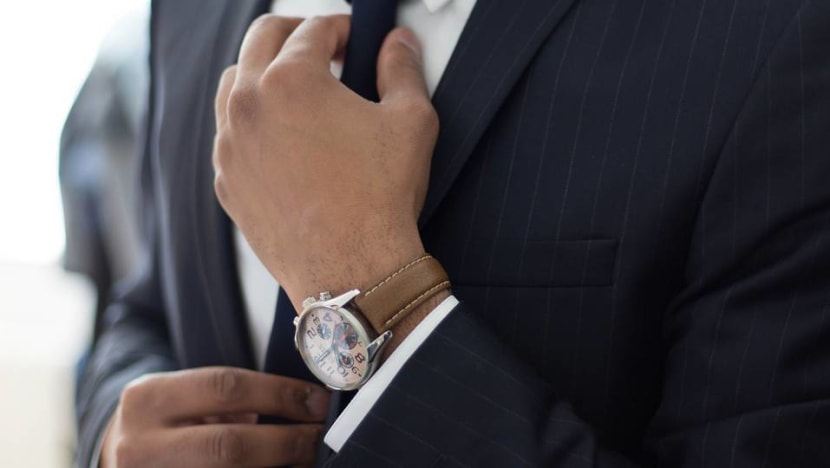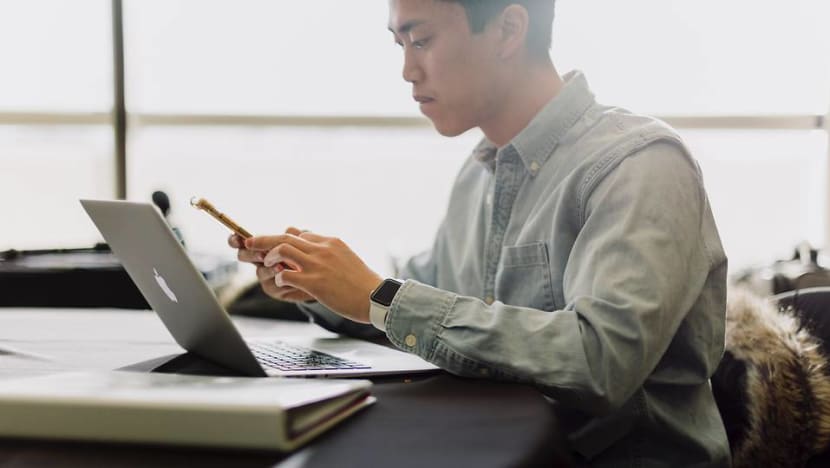commentary Commentary
Commentary: Missing the thrill of dressing up for work as a man
Though working from home has freed men from the strictures of the suit, there are advantages to maintaining professional style standards, says Christian Barker.

(Photo: Unsplash/Ruthson Zimmerman)
SINGAPORE: As someone who loves good tailoring and is rarely seen without a blazer, I’m probably not representative of the majority of the population.
But since beginning working from home several months ago, one thing I really miss is getting up in the morning and putting on my formal workday garb.
Dressing for work — even if you’re not going out to an office — has a potent psychological effect. It puts you in get-up-and-go mode.
Writers, adept at working from home, have adopted this technique since time immemorial. American novelist John Cheever, for instance, had a ritual of dressing each morning in full suit and tie, before spending the day writing alone in his basement workspace.
While not quite following Cheever’s example, I do habitually put on a button-up shirt and make a point of wearing a blazer or suit jacket while conducting video-call interviews. But it seems that I’m in the minority.
READ: Commentary: Does long-term WFH mean goodbye to makeup?
READ: Commentary: Here’s what people who criticise plastic surgery don’t get
“My customers overwhelmingly tell me they’re dressing very casually at home,” says Singapore’s foremost bespoke tailor, Kevin Seah.
“They’re getting up in the morning and putting on shorts, a T-shirt or polo shirt. Maybe a shirt, if they have an important Zoom call.”
This relaxed approach is somewhat surprising, given that Seah’s customers are men for whom dressing well is a pleasure, never a chore.
A CHANCE TO DRESS UP AGAIN – LIKE THE TWENTIES
This growing trend of dressing down since the coronavirus confined us to our homes is probably more accurately described as a relentless global onslaught.
The man who created the blueprint for the power suit with his endlessly influential tailoring for the character Gordon Gekko in 1987 film, Wall Street, is Alan Flusser. He has since dressed most of Manhattan’s corporate, financial and political elite.

Yet when asked whether his customers have been wearing fancy smoking jackets, cravats and velvet slippers around the house during quarantine, or an old college tee, track pants and Adidas slides, he replies: “Definitely the latter.”
Flusser explains: “Most of my New York customers are living out at their holiday homes in the Hamptons, and are not planning to come back (to the city) anytime soon … People are saying to me, ‘I haven’t put on a pair of trousers in four months. I’ve been living in a T-shirt.’ Even if you wanted to put on a sports coat, where would you wear it? The restaurants and bars are all closed. Where would you go?”
Here in Singapore, where bars and restaurants are gradually reopening with safe distancing measures in place, male clotheshorses are tapping on a desire to dress up and step out among some segments.
READ: Commentary: I miss my regular bar – but I accept I might never get to return, even after circuit breakers are lifted
READ: Commentary: We are becoming a 'dabao nation' – why does it feel like a bad thing?
“For this sort of gentleman, it’s a real delight to put on a beautifully tailored jacket and go for a nice meal,” says Seah. “After months stuck at home in casual clothing, they can’t wait to dress up again.”
Our current situation is often described as an unprecedented crisis, but that isn’t quite so. The circumstances surrounding the Spanish Flu that ravaged civilisation a century ago parallel those we’re facing today.
Then, as now, amidst a global health disaster, businesses and economies faltered, people were confined to their homes and wore masks when they ventured out.
When the flu eventually cleared, what followed was a decade of celebration, expressed not only in the way people lived, but how they dressed.
The Roaring Twenties saw men re-embrace peacockery with a gusto not seen since the late 18th century, when George “Beau” Brummell killed off the vogue for colourful, foppish attire and brought a new shades-of-grey sobriety to men’s style.
In the 1920s, despite the United States’ prohibition of alcohol, sobriety was by no means the order of the day. Men possessed of the wherewithal — such as F Scott Fitzgerald’s fictional Jazz Age bootlegger tycoon, Jay Gatsby — dressed intoxicatingly in silk shirts, vibrant tailoring, two-tone shoes and glitzy gem-studded accessories.

Women, decked in fur coats and fringe wraps, bold Art Deco dresses and brilliant strings of pearls, sashayed around with beaded purses and feather headbands in glorious evening parties.
Will we see a similar period of flashy style prevail, once a vaccine is developed and we’re fully liberated from the clutches of COVID-19 quarantine?
Leading British tailor Timothy Everest feels this may be the case for a segment of the population, at least.
“Hopefully we’ll see a bit more colour and pattern, people might want to be a little more flamboyant in a way,” he suggests. Many, though, will swing the other direction.
“When jobs are difficult to find, people do become more conservative in the way they dress. The Japanese say when times are tough, they dress British, because it’s conservative, and when times are buoyant, they wear Italian style,” which is more exuberant, Everest says.
That’s the great difference between the 1920s and 2020s — we are experiencing a drastic economic downturn, whereas Gatsby’s day was a boom-time. An ongoing depression will inevitably breed drab dressing.
“The way someone dresses depends upon their mood,” Seah says. “People are feeling down at the moment, so they’re dressing down.”
READ: Commentary: I’ve been career oriented my whole life, until the COVID-19 pandemic took my ambition
Though he has a vested interest in the continued popularity of tailoring, New York clothier Flusser believes men will emerge from this crisis wearing more casual clothing than ever before.
“The only ineluctable, constant trend in fashion is the casualisation of dress. It’s been going on uninterrupted for a long, long time,” he says.
“It’s a very seductive proposition for a man, the opportunity to work or do anything, really, in something more comfortable. And once you spend enough time in clothes that are simply about comfort, action, movement, the genie is out of the bottle. It’s hard for people to go back.”
THE SHIFT TOWARDS CASUAL WEAR
Even before COVID-19 made work-from-home the default, we had already seen financial institutions such as Goldman Sachs introducing a casual wear-friendly dress code.

Young guys in banking today talk about “the suit” they need, whereas in previous decades, they required several, Everest told me.
Now, forced to work from home, even lawyers are becoming less particular, insofar as dress standards go.
A friend, who’s a partner at the Singapore office of a leading international law firm, describes how things have changed within his previously super-formal profession. “We’re still settling upon the precise standards for Zoom meetings,” he notes.
“But suits are rarely if ever seen, beards are bushier and ties are optional at best.” What’s worn on one’s lower half is purely a matter of personal preference.
I’m not at all ashamed to admit that, in the series of Instagram Live interviews I’ve conducted over the past three months, despite maintaining an immaculately tailored appearance up top, I’ve worn Bermuda shorts every time. It’s comfortable, practical — and invisible.
In most pre-COVID workplaces, long pants were a given, a must. Working from home, that’s no longer the case.
Plenty of people are losing their shirts (in both financial and sartorial senses) because of this crisis. It appears many of us may lose our trousers as well.
LISTEN: Disruption 101: How COVID-19 is revolutionising work
BOOKMARK THIS: Our comprehensive coverage of the coronavirus outbreak and its developments
Download our app or subscribe to our Telegram channel for the latest updates on the coronavirus outbreak: https://cna.asia/telegram
Christian Barker is a journalist and editor with two decades' experience writing about men's style and luxury for publications including The Rake, Forbes Asia, Robb Report, GQ and Esquire.














